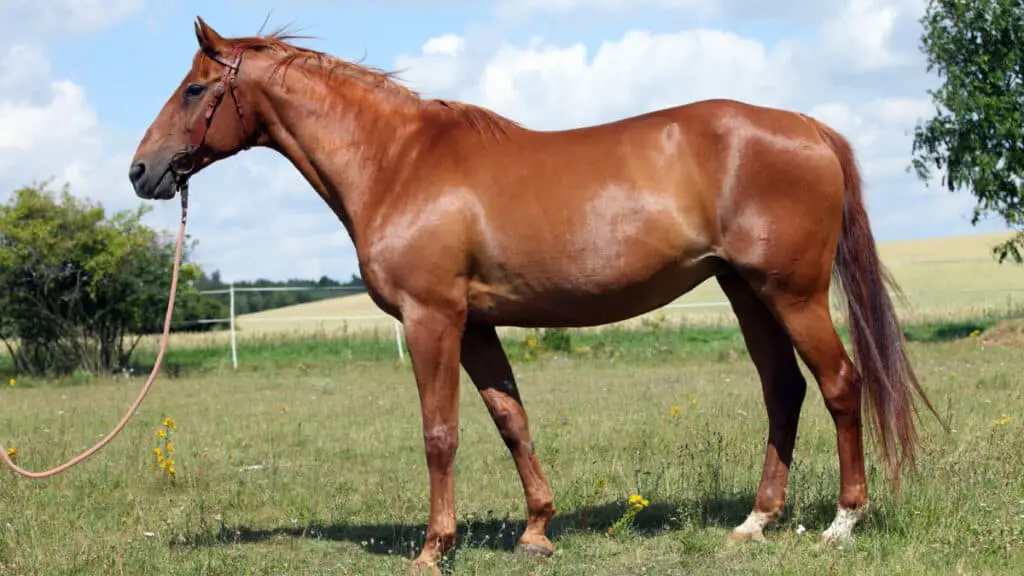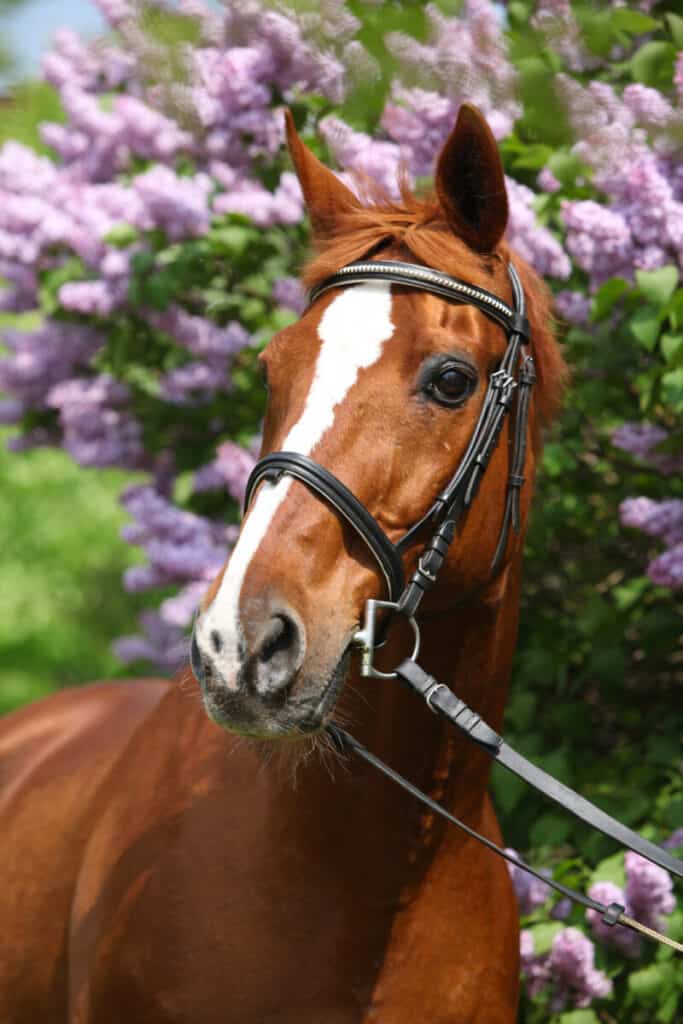Skip To Section
The Budyonny horse, also known as the Budenny or the Budennovsky horse, is a Russian breed that was developed by a notable Bolshevik cavalry commander named Marshall Semyon Budyonny after the Russian Revolution.
It is a horse best known in the present day for being an ‘all-rounder’ – originally created for use in battle, in later years it has cemented a reputation for being a champion competitor in racing, dressage, and carriage driving.

History
After the devastating losses of men and horses alike in the wake of the Russian Revolution and World War 1, the need for cavalry replenishment was significant. Marshall Semyon Budyonny was up to the task, already being a keen and experienced horse-breeder on top of possessing an extensive military knowledge.
He began his quest to create the perfect military horse in the early 1920s, at a stud farm in the region of Rostov, in the Southern Federal District of Russia.
Budyonny’s love of horses ran so deep that when World War 2 began to flourish and the birth of new technologies made way for tanks to supersede the use of cavalry horses in battle, he proclaimed that “the tank could never replace the horse as an instrument of war.”
After many years of refining and polishing, the Budyonny breed was officially recognized in 1949, thus making it a relatively new breed by today’s standards.
A number of Budyonny horses were released onto an island on the Manych Lake in Rostov in the 1950s as part of an experiment to test their voracity and ability to adapt to harsh weather conditions and determine if they could cope without human assistance.
As a testament to the breed’s hardiness, in the years that followed, the horse population not only maintained but grew substantially.
Characteristics
The modern Budyonny is a horse of satisfactory height with a sturdy, solid build and a muscular, strong body. Their typical conformation includes a straight profile, well-proportioned linear heads, long necks, sloping shoulders, an impressive, deep chest, a lengthy, level back, and a slightly sloping croup. They feature long, brawny legs with well-developed joints and shapely hooves.
They are considered warm-blooded horses, due to a combination of their hot and cold-blooded Don and Thoroughbred parentage (more on this in the breeds section) and their reputations as all-rounders, suitable and adaptable for a wide range of uses.
Their warm-bloodedness also relates to their general good temperament and calm nature. They also possess a reputation for being particularly loyal; they have been said to “bond with their handler as befitting a breed destined to be a soldier’s partner.”
Sub-categories
In the early stages of development, the breed could be separated into three sub-categories, namely: “Massive,” “Eastern,” and “Middle” types.
- The Massive type was just as it said on the tin; large, rough and bulky. They were notably sturdy, with a desired well-developed bone structure, and those which displayed more of a distinguished Oriental (see below) type were especially held in high regard. Their robust constitution made them ideal for herd keeping. Of the three, these were used mainly for heavier-duty carriage driving.
- The Oriental type weighed considerably less than the Massive and possessed a more elegant appearance. Generally chestnut with a gold sheen or bay, they demanded higher maintenance with regard to their feed and care.
- The Medium type was fairly large and well-muscled, but also long-limbed and athletic. They were faster than the other two types and closer resembled the Thoroughbred parentage.
As time went on, the growing demand for competition horses led to the integration of the three sub-categories into a single type with a larger proportion of Thoroughbred blood.

Breeding And Uses
First and foremost, the magnificent Budyonny was developed to be a noble and robust military horse. With World War 1 and the Revolution just behind them, having stretched for a total of 9 long, bloody years, Russian forces needed to replenish their cavalry mounts with the best of the best.
It was the prime opportunity to create a breed featuring only the finest qualities; power, stamina, fighting spirit, intelligence, and fearlessness. Moreover, endurance was essential – throughout WW1, horses were often required to clear up to 100km in a day, for several days straight, on minimal rest and inadequate food supplies.
Between WW1 and 2, the Budyonny breed, fortunately, had rigorous testing and training to ensure they could withstand and meet extremely high standards. World War II proved to be the ultimate test – one they passed almost seamlessly, proving their worth and a credit to their bloodlines.
After the calvaries were demobilised due to the rise of vehicles and machinery in the 1950s, the celebrated breed was tried at sports and racing, at which it also became a roaring success.
The need for the hardiness and durability of the weathered Don parent horses were no longer a necessity, and more Thoroughbred blood was added to the breeding process to increase their speed and agility. Steeple chasing was an easy event to pick up for the Budyonny – one even came in first place at the Grand Pardubice Steeplechase (the Czech Grand National) in 1964.
Today, the Budyonny also performs brilliantly in dressage, carriage driving, show jumping, and racing.
What Horse Breeds Make Up The Budyonny?
Marshall Budyonny utilised Russian Don and Chernomor mares and crossed them with English Thoroughbred stallions to create his new breed. Blood from Kirghiz and Kazakh horses from neighbouring countries was also initially incorporated due to their reputation for good stamina and general hardiness.
The foundation stock was made up of 657 mares, of which were:
- 359 Anglo-Don
- 261 Anglo-Don/Chernomor mixed breed
- 37 Anglo-Chernomor
These mares were given the very best veterinary care, highest quality food and underwent rigorous management and their care was backed by extensive Governmental support. They were the horse royalty of the time!
Marshall Budyonny personally oversaw the entire early selection and development process of the breed. The foals were broken in from the age of one and a half. From the age of two up until the age of four, the young stock was tested under both racing and cavalry conditions.
Size
The Budyonny horse typically stands between 15 and 16 hands. They can weigh roughly around 1,190 lb (540 kg).
Colors
Most commonly (around 80%), the breed sports chestnut coats with a golden sheen/shimmer, which is said to be a main contribution of the Russian Don lineage. More rarely, they have been known to be grey, bay, or black.
What Are They Used For?
In the present day, they are used for several activities including:
- Carriage pulling
- Show Jumping
- Dressage
- Steeplechase
- Racing
- Endurance riding
Where Do They Live?
Today, the Budyonny is primarily found right where it originated; in Russia and the close surrounding countries, such as Kyrgyzstan, Kazakhstan, and Ukraine. However, there is said to be a diminutive population of Budyonny in the USA, with their rarity resulting in them fetching a hefty price tag.
Conclusion
The beautiful Budyonny breed has withstood great hardship in its relatively short existence, but not even the trials and tribulations of a world war could conquer this noble line of horses.
However, despite its excellent parentage and dedicated, precise breeding programme by the best in the business (with thanks to both military and equestrian masters), the breed is now in decline and threatened with endangerment.
Although proving its worth on the battlefield and in the competition ring, the Budyonny is a stellar horse whose fame peaked at its calling as a distinguished, brilliant war horse.
There’s a whole world of horse breeds out there to explore! Discover and find out more information by checking out our horse breed guides.

